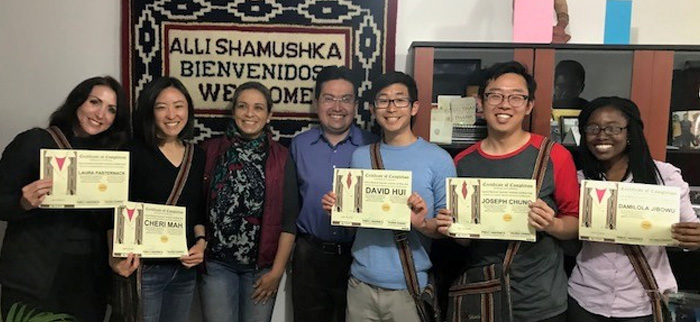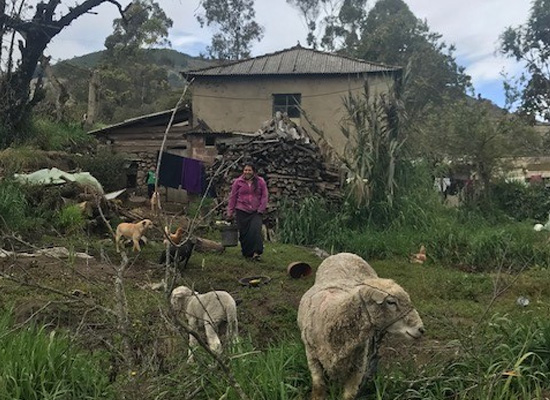Laura Pasternack

Riobamba, Ecuador, Cachamsi
Senior Elective April 2018
"I had a great feeling about the people and the country from the moment that I arrived in Ecuador. People helped out one another there, stranger or not. I had no expectations about the rotation itself, but I was amazed with Cachamsi, the program I was working with. They coordinated with all the hospitals and medical clinics in Riobamba and Cacha, where the indigenous people live. They also arranged for me to live with a wonderful host family which forced me to practice my Spanish outside of the medical setting. I spent three weeks at Centro de Salud, one of the national health clinics that opened two weeks before I arrived. The clinic was just as nice, if not nicer than, any clinic I have visited in the U.S. Every Wednesday they held Zumba classes in front of the clinic for the community and there was an impressive turnout.
"My focus on my first rotation was pediatrics, but in general the diseases that were most commonly seen were: colds, Strep throat, hypertension, renal stones, work-related injuries, osteoarthritis, diabetes, dermatitis, and diarrhea-related illnesses. According to the doctors, renal stones are very common even in children due to the high calcium content in the water.
"There are two different cultures in Riobamba, that of the indigenous people and that of the mainstream Ecuadorian culture. Only indigenous people live in Cacha, where my second rotation took place. . They were warm, friendly farming people who worked very hard and had a strong sense of community. Interestingly, in both Cacha and Riobamba, doctors spend at least one day a week doing home visits to designated neighborhoods. This was one of my favorite aspects of this rotation because you got a better sense of the life of the patient you were treating.
"I was very impressed with how compassionate and kind the doctors were in their interactions with patients. They understood the power of touch and a greeting smile. The doctor-patient interaction is more paternalistic than in the U.S. though. It was rare to hear a patient question the diagnosis or treatment plan. I believe this has to do with the strong hierarchy of class that is present in society there.
"One of the coolest discoveries I made during my time in Ecuador was a natural remedy called Sangre de Drago (dragon's blood), a sap and bark mixture from the croton tree in the Amazon. I received a couple of deep cuts during a visit to the Amazon and a local guide there applied this to one of my wounds and it healed completely within three days. On my other hand I applied Neosporin to the wound and sadly it still has not fully healed two weeks later. Sangre de Drago also helped alleviate the itch and wounds that come from insect bites. According to the Natural Medicines Database, there is insufficient evidence for its effectiveness on insect bites, but my friends and I are true believers after receiving over 200 mosquito and sandfly bites between the 3 of us.
"In Ecuador, everyone eats a heavy carbohydrate diet. There are few low-carb options that you can eat on the run (no such thing as protein bars here). Most healthy foods needed to be cooked and prepared in the kitchen. People don't eat much prepackaged foods and those that exist are very high in fat and sugar. 'Diet items' aren't really a thing there, but they do sell diet coke. Everyone eats soup as part of their lunch, and all family members leave their school and work to go home and enjoy lunch together. Also, guinea pig is a delicacy there!
"Many taxis and cars don't have seat belts, and many stray dogs walk the streets. One tourist came into the clinic after being bitten by a dog, so I recommend watching your back and not petting them or walking too close to fences. Another interesting thing is that you dispose of used toilet paper in a trash bin instead of in the toilet, and toilet paper can be scarce so you always need to carry tissues with you. Also, very few people smoke there.
"The most challenging aspect of my experience was the uncomfortable feeling of having to speak to connect with others and try to be understood. It's what I imagine residency will be like—you've studied the information, but actually applying that knowledge to real life takes a lot of practice. Practice when you are tired, uncomfortable, or just don't feel like socializing. It paid off for me! I may not speak Spanish perfectly now, but I understand almost everything and can get my point across the majority of the time.

"For people who may be traveling to Ecuador, I recommend this list of essentials to bring that are more expensive or difficult to find there: quick dry towel, waterproof bandaids, sunglasses with UV protection, protein bars, benadryll, ibuprofen, anti-diarrheal, cough drops, bug spray, sunscreen, light waterproof rain jacket, multiple ziplock bags of various sizes, tums, thank you cards, headlamp, solar-powered phone charger or external battery, hiking boots, tweezers and small sharp scissors, lifestraw water bottle or UV filtration (for hiking), N95 mask, and ear plugs.
"Finally, I was very surprised by how safe I felt in Riobamba. People were very friendly, laid back and were always happy to help one another. It is a hard, happy life there, but I absolutely loved it!
Back to Top